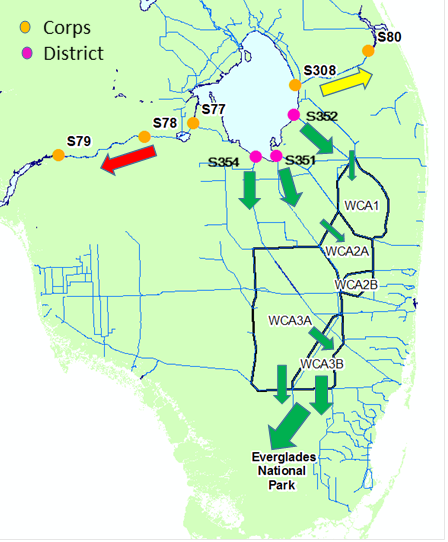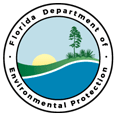|

FOR IMMEDIATE RELEASE: April 14, 2016
CONTACT: DEP Press Office, 850.245.2112, DEPNews@dep.state.fl.us
DEP'S DAILY UPDATE ON LAKE OKEECHOBEE
In an effort to keep Floridians informed of the state’s efforts to protect the environment, wildlife and economies of the communities surrounding Lake Okeechobee and the Caloosahatchee and St. Lucie estuaries, the Florida Department of Environmental Protection is issuing a Lake Okeechobee status update each weekday. These updates will help residents stay informed of the latest rainfall and lake level conditions, as well as the latest actions by the State of Florida and U.S. Army Corps of Engineers.
Summary of the State of Florida’s Actions:
- On April 7, 2016, the U.S. Army Corps of Engineers announced that it would keep flows at current rates. Click here for more information.
- On March 17, 2016, Governor Rick Scott activated Florida’s Small Business Emergency Bridge Loan Program for more than 100 businesses affected by the federal government’s water releases from Lake Okeechobee. Earlier this month, Governor Scott directed the Florida Department of Economic Opportunity (DEO) to activate a business emergency operations center to survey businesses damaged by the water releases in Lee, Martin and St. Lucie Counties. After receiving survey results, DEO has opened the application period for loans to eligible small businesses from March 16 to April 30, 2016.
-
The Florida Small Business Emergency Bridge Loan Program provides short-term loans to assist a business until other financial resources are secured after a natural disaster. To see if a business is eligible or to complete an application by April 30, 2016, visit floridadisasterloan.org. For additional questions regarding local administration of the Emergency Bridge Loan Program, contact the Florida Small Business Development Center Network at
239-745-3704 (Lee County) or 772-462-7069 (Martin and St. Lucie Counties).
- The South Florida Water Management District has responded to record January rainfall by moving billions of gallons of clean water to relieve high water levels in two critical locations. This unprecedented response includes:
- 2.7 billion gallons of water moved into the A-1 Flow Equalization Basin from Lake Okeechobee. To reduce harm to the St. Lucie and Caloosahatchee estuaries from the U.S. Army Corps of Engineers' Lake Okeechobee releases, the District began emergency operations in early March to send lake water directly into this new reservoir.
- Water managers began emergency operations on Feb. 15, 2016, to move water from the vast wetlands in Miami-Dade and Broward counties to Everglades National Park. The record rainfall left water levels too high for Everglades wildlife in WCA-3.
- By raising the L-29 canal level, per an order from the U.S. Army Corps of Engineers and at the request of Governor Rick Scott, the South Florida Water Management District has been able to move approximately 46.2 billion gallons of clean water into the northern portions of Everglades National Park, as of midnight on April 13, 2016.
-
On Feb. 26, 2016, Governor Rick Scott signed Executive Order 16-59, which declares a state of emergency in Lee, Martin and St. Lucie counties, following heavy rainfall that has resulted in the U.S. Army Corps of Engineers frequently discharging water from Lake Okeechobee to the St. Lucie and Caloosahatchee estuaries. This is a result of inadequate funding by the federal government. Governor Scott called on the Obama Administration to fully fund the more than $800 million in needed repairs to the federally operated Herbert Hoover Dike to safely hold water to prevent these discharges. To view the Executive Order, click here.
- On Feb. 11, 2016, Governor Rick Scott requested that the U.S. Army Corps of Engineers take immediate action to relieve flooding of the Everglades Water Conservation Areas and the releases of water from Lake Okeechobee to the Caloosahatchee and St. Lucie estuaries. Click here to read the letter.
- The Florida Department of Environmental Protection and the Florida Fish and Wildlife Conservation Commission (FWC) issued orders on Feb. 11, 2016, that would allow the U.S. Army Corps of Engineers to move forward with this request. Click here to read the orders.
-
On Feb. 15, 2016, the U.S. Army Corps of Engineers agreed to Governor Scott’s request to raise water levels in the L-29 canal in order to move water south through Shark River Slough to ease the effects of flooding in the Everglades. The South Florida Water Management District began operation of the S-333 structure at 5:30 p.m. on Feb. 15, 2016, after the state received an order from the U.S. Army Corps of Engineers.
Lake Conditions:
|
Current Lake Level
|
14.78 feet
|
|
Historical Lake Level Average
|
14.01 feet
|
|
Total Inflow
|
2,980 cubic feet per second
|
|
Total Outflow
(by structures operated by the U.S. Army Corps of Engineers)
|
8,350 cubic feet per second
|
|
Evapotranspiration
|
5,370 cubic feet per second
|
|
Net
|
-10,740 cubic feet per second
|
|
Lake level variation from a week ago
|
-0.24 feet
|
Florida Fish and Wildlife Conservation Commission's Wildlife Update:
The FWC continues to monitor water levels and the status of wildlife in three Wildlife Management Areas (WMAs) in South Florida within the Everglades ecosystem. The three areas, Everglades and Francis S. Taylor WMA, Holey Land WMA and Rotenberger WMA, encompass 736,881 acres. These WMAs provide important habitat for a diversity of imperiled wildlife species, including the Everglades snail kite, Everglades mink, little blue heron, tri-colored heron, snowy egret, white ibis, wood stork and limpkin, as well as native and abundant species like American alligators, white-tailed deer and marsh rabbits.
-
FWC’s monitoring efforts include periodic wildlife and habitat surveys. FWC staff continues to watch water gauges to monitor high water levels and the impacts and stresses they may be having on areas like the Everglades tree islands, which are critical to the survival of Florida wildlife species. High water levels can seriously impact nesting and feeding activities of our native birds and make large and small mammals much more vulnerable to disease, starvation and predation. The condition of habitat on tree islands is an important indicator for the level of stress being experienced by wildlife.
-
As of April 13, 2016, water levels within the three WMAs previously listed are approaching criteria for rescinding the special regulations that limit public access. Criteria for rescinding the special regulations is a combination of water level and wildlife observed on surrounding levees.
Everglades WMA:
- Water level (average of 62/63 gauges) as of April 13 = 10.86 feet
- High water closure criteria = 11.60 feet
- Regulation schedule = 9.82 feet
- Average for this time of year = 9.83 feet
- Recession rate for the last week = -0.25 feet
- Water level trend over the past 3 weeks = dropping
Rotenberger WMA:
- Water level as of April 13 = 12.73 feet
- High water closure criteria = 13.50 feet
- Regulation schedule = 12.47 feet
- Average for this time of year = 12.07 feet
- Recession rate for the last week = -0.11 feet
- Water level trend over the past 3 weeks = dropping
Holey Land WMA:
- Water level as of April 13 = 11.83 feet
- High water closure criteria = 12.50 feet
- Regulation schedule = 11.15 feet
- Average for this time of year = 10.64 feet
- Recession rate for the last week = -0.13 feet
- Water level trend over the past 3 weeks = dropping
Wildlife surveys conducted on WMA levees and tree islands during the past week suggest use by wildlife has continued to decrease as a result of receding water levels in all of the WMAs. Typically this time of year (four months into the seven-month nesting season), we observe increased wading bird nesting, but so far, only very limited nesting and foraging has been observed. There are 13 active snail kite nests within the Everglades WMA – eight within Water Conservation Area (WCA) 3A and five within WCA 3B. As of April 13, 2016, this high water event has lasted 75 days.
As a result of FWC’s continued observations, the special regulations that limit public access for the three WMAs will continue. As water levels drop significantly below the established criteria, wildlife will have delayed responses and conditions typically do not improve for at least a week or more. Once conditions improve for wildlife, FWC will recommend an order to rescind the current special regulations.
Members of the public should report any distressed fish or wildlife to the following FWC hotlines:
- Wildlife Alert Hotline: 1-888-404-3922 or Tip@MyFWC.com
- Fish Kill Hotline: 1-800-636-0511
Lake Okeechobee Management Information:
|

The figure above depicts various flood control structures that the U.S. Army Corps of Engineers (Corps) and the South Florida Water Management District (District) operate. The arrows illustrate the direction of water flow. The red arrow indicates discharges that are at levels that lower salinity to the poor range. The yellow arrow indicates discharges that are at levels that allow for salinity to increase, but only into the fair range. The green arrows show the movement of water from Lake Okeechobee to the Everglades Agricultural Area, and the movement of water from the water conservation areas into the L-29 canal to avoid potential ecosystem impacts at Everglades National Park. The district began this movement on Feb. 15, 2016, after receiving an order from the Corps at the request of Governor Scott.
|
|
Structures
(see map above)
|
Federal Release Guidance
(based on 2008 Lake Okeechobee Regulation Schedule)
|
Daily Average Releases
(based on the U.S. Army Corps' C&SF System Status Update as of midnight 4/13/16)
|
|
East – S-308 (operated by U.S. Army Corps of Engineers)
|
N/A
|
1,510 CFS
|
|
East – S-80 (operated by U.S. Army Corps of Engineers)
|
Up to 1,170 CFS
|
1,710 CFS
|
|
West – S-77 (operated by U.S. Army Corps of Engineers)
|
Up to 3,000 CFS
|
4,110 CFS
|
|
West – S-79 (operated by U.S. Army Corps of Engineers)
|
N/A
|
4,010 CFS
|
|
South - 3 structures (operated by South Florida Water Management District)
|
N/A
|
2,530 CFS
|
|
The table above depicts the guidance for releases from the lake based on
the Corps' 2008 Lake Okeechobee Regulation Schedule as compared
to the actual daily average releases.
|
Salinity Conditions:
Caloosahatchee Salinity Conditions: Salinity (based on optimal conditions for adult oysters) is increasing and is in the good range at Shell Point and Sanibel, and in the poor range at Cape Coral.
St. Lucie Salinity Conditions: Salinity at the U.S. 1 bridge is within the fair range. The salinity at A1A is in the good range.
Rainfall Information:
During the past three days, there has been 0.052 inches of rainfall over the region.
South Florida Water Management District's Rainfall Forecast:
Rainfall for the current week is forecast to be average. Light to moderate showers and thunderstorms should develop mainly north and northeast today as the frontal boundary moves into Central Florida. Some locally heavy shower activity will occur on Friday and Saturday. A frontal boundary should move south of the district on Sunday and breezy northeast winds should bring some persistent showers east during the day before drier conditions spread over the district on Monday, Tuesday and Wednesday.
|



